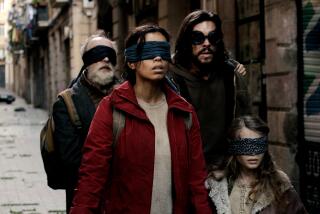‘Thief’ Still Steals the Show
- Share via
Vittorio De Sica didn’t set out to become a political filmmaker. He was more interested in art, in lyricism, in conveying the ineffable.
De Sica said as much later in his career, well after his reputation as one of the leaders of Italy’s neo-realist movement in cinema had been established. In particular, he pointed to the celebrated “The Bicycle Thief” as a clear example of his commitment to poetry.
The 1949 movie, screening tonight as part of the Bowers Museum’s Italian Film Festival, tells the simple but not simple-minded story of a poor laborer and his son as they try to find their stolen bike. The backdrop is postwar Italy, a country left devastated by Mussolini, World War II and fascism.
Poverty is everywhere; bomb rubble remains on street corners, and people look as grim as their surroundings. In describing a period beset by socio-political problems, De Sica couldn’t help but become one of the more influential socio-political directors of the day.
“The Bicycle Thief” is a classic for several reasons, many tied to the understatement of De Sica’s vision, which just makes the film all the more powerful. De Sica strips “The Bicycle Thief” to the essentials; it refuses to be pushy, and you tend to search out your own connection to the events, coming up with resonant interpretations.
The naturalistic tone starts with the first scene, a sequence showing unemployed workers anxious for jobs in front of a government office. The protagonist (Lamberto Maggiorani) momentarily discards his pessimism when offered work raising posters advertising a Rita Hayworth flick.
He needs a bicycle to get to the sites around town but has pawned his own for food money. Faced with losing the job, his wife (Lianella Carrell) sells her dowry (six pairs of bed sheets) so Antonio can redeem the pawn ticket. The bike is stolen the next day, while he’s working.
Antonio and his young son, Bruno (Enzo Staiola), begin a three-day search that takes them from a church to a bordello to a soothsayer’s home to a dangerous confrontation in the thief’s neighborhood. As Antonio’s frustration grows, and Bruno’s confusion over his father’s anger increases, their world becomes more precarious. The film is a condemnation of what the war left behind; it’s subtly anti-fascist.
“The Bicycle Thief” is also revealing on a technical level. De Sica, true to the neo-realist style, used natural lighting exclusively, giving the movie a gritty, documentary-like quality that many other filmmakers tried to emulate.
The stripped-down approach was calculated. Along with Roberto Rossellini’s “Rome, Open City” (1945) and Luchino Visconti’s “Obsession” (1942)--both neo-realism landmarks--”The Bicycle Thief” was, in part, a reaction to the studio-made, government-controlled products of the 1930s. De Sica and others relished their roles as outsiders bucking the system.
Nonetheless, the film won several European awards and soon came to the United States. Censors here weren’t so appreciative, fighting to keep it out of theaters because of scenes involving hookers and Bruno’s rather discreet attempt to urinate on a wall. Eventually, though, the quality of “The Bicycle Thief” shut up critics, and it went on to garner the 1949 Oscar for best foreign film.
What: Vittorio De Sica’s “The Bicycle Thief.”
When: Thursday, Aug. 11, at 7:30 p.m.
Where: The Bowers Museum, 2002 N. Main St., Santa Ana.
Whereabouts: Take the Santa Ana (5) Freeway to 17th Street and head west to Main Street, then head north.
Wherewithal: $4.50 for adults; $3 for seniors and $1.50 for children 12 and under. Museum admission comes with ticket.
Where to call: (714) 567-3600.
More to Read
Only good movies
Get the Indie Focus newsletter, Mark Olsen's weekly guide to the world of cinema.
You may occasionally receive promotional content from the Los Angeles Times.










